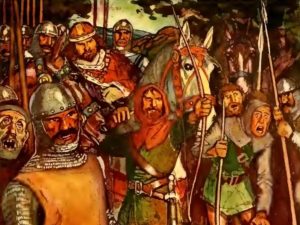Robin Hood & The Civil War: “The Scott Effect” (Part 3)

Part of a series
An old whaling ship was not the only example of Robin Hood’s name appearing in mid-19th Century America. In fact, a search for the English outlaw’s name in newspapers from the Civil War era turns up a variety of musical pieces, analogies and examples, and literary stories.
So what did Americans believe about Robin Hood and how did they view the legendary archer?
In a nutshell, Robin Hood symbolized “an ancient member of olden chivalry.”[i]
A minister gave a lecture for the benefit of a hospital in 1862, comparing Robin Hood and John Wycliffe. Although his presentation was reportedly not well attended or received, the article gives some insight on what people thought of the Sherwood archer. Robin Hood was described as “an outlaw. . . roaming free in the forest. . . . They had no authentic record of Robin Hood, for it was doubtful if they could assume the numerous ballads and songs concerning Robin Hood, to record the doings of a real man rather than some object of the popular imagination. The lecturer, however, took it that such a man did exist; and he held that Robin Hood and Wycliffe were virtually connected—that both in part, and each fully represented the popular elements in England which outlived the Norman conquest, and which more and more were developed from the 13th Century out, and which were today the roots of all the radical liberty and power we now enjoyed and boasted of. To show this the lecturer entered into a lengthy historical exposition. . . .”[ii] And the rest of the lecture report opens a myriad of topics beyond the scope of this post.
Where was the recognition of the Robin Hood legends and stories coming from? Romantic Era literature and the new publishing form—novels—brought a revival of interest in stories of Olde England. While there were many writers on both sides of the Atlantic who enjoyed spinning the legends further from the old folklore and ballads, one particular author renamed and reimagined Robin Hood and brought him into American thinking in a unique way: Sir Walter Scott.
Walter Scott, a Scottish playwright, novelist, poet, and historical researcher, helped to invent the genre of historical fiction. Living from 1771 to 1832, Scott’s novels took continents of readers by storm, sweeping them into romantic ideals of medieval eras. In one of his most famous works—Ivanhoe—the author took the shadowy figure from Sherwood Forest, rebranded the legends and even renamed the hero: Robin of Locksley.
Robin of Locksley in Ivanhoe splits an arrow in an archery skill show at the Ashby Tournament, saw himself as the guardian of the forest who expressed outrage at nobles using his name for kidnapping purposes, leader of a band of good-hearted outlaws, and a leader ready to defy the odds to save friends and England. Consistently through the story, Locksley is referred to as a “stout yeoman” and literary critics have come to interpret him as representing the rising middle class.
Walter Scott’s novels influenced the American mind. Northerners and southerners read them differently at times, but some ideas of social “castes,” folkloric heroes, chivalry, and men’s and women’s roles can be trace into the literary effect. I informally call it “the Scott Effect” when I come across it in Civil War writings; it’s distinctive and probably deserves a blog post of its own since it does influence 1860s thinking and responses.
Thanks to the “Scott Effect” and other literary efforts, many Americans were familiar with the stories of Robin Hood during the Civil War era. But it didn’t stop with the novels, Robin Hood made his way into 19th Century pop culture and we’ll look at some examples and ask all important question “why?” in the next posts of the series.
To be continued…
Sources:
[i] Buffalo Morning Express and Illustrated Buffalo Express (Buffalo, New York)12 Jun 1861, Page 1. (Accessed at Newspapers.com)
[ii] The Brooklyn Daily Eagle (Brooklyn, New York)29 Jan 1862, Page 2. (Accessed at Newspapers.com)